Texas is well-known for its spring wildflowers: Bluebonnet, Lupinus texensis
…Pink evening primrose, Oenothera speciosa,
…Firewheel, Gaillardia pulchella,
…and so many others. Folks from far and wide travel to Texas to view the spring wildflower show. In a good year, open spaces and home gardens are resplendent with color from all parts of the color wheel.
I don’t grow any of the famed Texas wildflowers in my personal garden. Alas, my soil is too heavy and my space too shady for the prairy/grassland flowers that most identify as quintessential Texas wildflowers. But I certainly love and grow many other native Texas plants and wildflowers and a favorite in bloom right now is a group belonging to the Commelinaceae family–the pride of purple–Tradescantia or Spiderwort.
There are 19 species of Tradescantia throughout North America, almost half of which reside in Texas. A woodlands plant, Spiderwort thrive in a variety of soils, but generally prefer part-shade to shade exposure, though it grows well in more sunny conditions, too. In short, it’s not a picky plant.
I can’t tell you exactly which one of the Tradescantia that are in my gardens because different Spiderwort mix-n-match with one another, hybridizing readily and creating variations in color,
…height,
…and petal shape.
I started with several individuals gifted to me a few years ago and they’ve self-seeded with aplomb. Some clumps of these purple zingers trend very purple,
…and others lean-to the lavender side of things.
I think the majority of my Spiderwort plants are the Giant spiderwort, Tradescantia gigantea, if only because most of them are just so darned tall.
And so darned purple.
Spiderwort pop up in the late fall or winter, sporting grass-like foliage; during the cool season the foliage grows and thickens.
As the days lengthen and temperatures warm, fleshy stalks shoot up from the base of the foliage.
In time, bloom clusters form atop those bloom stalks and purple play begins!
In my garden, Spiderwort blooms for a rather long period. Often, the flowering begins at the first of March (if not sooner) and continues well through May. Spiderwort plants are best situated in a more casual garden, though if kept in check, it’s a plant that could work beautifully in a formal setting. The key phrase is kept in check. Tradescantia re-seed with abandon and can prove weedy and thuggish if allowed to seed out ungoverned. You MUST weed wayward seedlings if they grow where they’re not wanted! A good time to discipline these rogue germinators is in winter and early spring, as the seedlings emerge.
If I see a mother plant and scads of babies at her feet AND I don’t want them–out they go! The seedlings are easily removed by hand or with a weeding tool.
Another strategy is to nip Spiderwort in the bud during the blooming season. Once I notice less flower production, it means that the seeds are developing and it’s time to snip.
I prune the flower stalks down to the base of the grassy foliage to lessen the spread of the prolific re-seeders.
I’m brutal with this process because I know that if I’m the least bit kind-hearted, Spiderworts will be everywhere in the garden. I still get plenty of new seedlings each year, but keeping Spiderworts in check prevents mayhem in the garden of the Spiderwort variety.
Despite its mission to spread, Spiderworts are valuable to pollinators and pretty for me to relish, and therefore, welcome in my garden–with practical limitations of course. Honeybees adore this plant and Tradescantia are visited by native bees and butterflies too.
From A Seasonal Look perspective, Spiderwort are primarily winter and spring plants. In a wet and cool autumn, the foliage will emerge early; in a wet and cool early summer, the blooms might last into June, the foliage a little longer. But once the heat of summer sets in and Spiderwort flowers have bowed out and relinquished the flower show to the heat lovers, the foliage…fades away. I can’t honestly say exactly when the foliage is no more–but eventually, it disappears. One of my strategies in planting for seasonal flowering is to plant early spring bloomers underneath the larger summer/fall blooming/berrying shrubs (many of which are herbaceous perennials). I’m certain that those particular Spiderwort plants hang on for a while after the peak of their blooms, shadowed and covered by the limbs of summer/fall plants. Since the Spiderwort plants are sheltered by the spread and height of the summer shrubs and perennials, I don’t notice what they’re doing–and I won’t notice (or think about) those Spiderwort plants again until winter’s first freeze renders the deciduous perennials inconsequential and the tell-tale grassy foliage of Spiderwort emerges from the chilled soil. The caveat is that many of the unwanted Spiderwort in my garden occur because I neglect to deadhead those soon-to-disappear-under-larger-plants Spiderworts. That’s the downside of planting them underneath larger plants: out of sight, out of mind.

Spring blooming Spiderwort growing amidst Frostweed, Verbesina virginica and Yellow bells, Tacoma stans. Both of these larger perennials will cover the Spiderwort by early summer.

Spring blooming Spiderwort will be overtaken by the rapidly growing Turk’s cap, Malvaviscus arboreus.

Spiderwort planted underneath a White mistflower, Ageratina havanensis. Most years, the Mistflower freezes to the ground, or nearly so, allowing the Spiderwort a good late winter and spring show.
For those free-standing Spiderwort individuals that drag into summer, their seasonal end is more obvious.
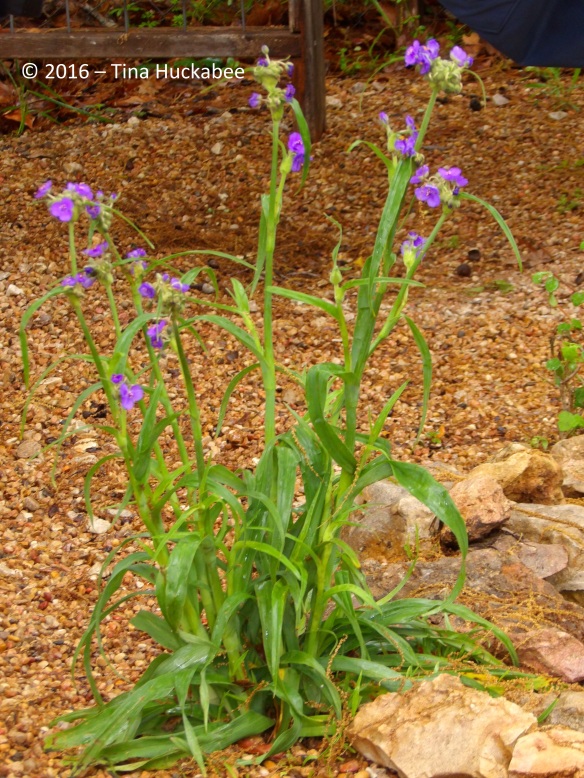
A self-seeded Spiderwort beside the pond. By late May, the bloom stalks will be pruned and by mid-summer, the foliage will wilt and the gardener will prune the foliage to the soil and toss in the compost bin.
What typically happens is that sometime in June or July, they become terribly droopy and sad–heat is not a friend to Spiderwort plants. I relieve any Spiderwort misery with my trusty Felco pruning shears, cutting down the remaining, sad foliage to the soil. The roots stay safe in the ground until more convivial conditions present and ready the Spiderwort story to begin again: lush winter foliage and enchanting spring flowers.
If basic preventative pruning and/or seedling weeding is employed, Spiderwort is a desirable spring wildflower for the garden with its lovely foliage and flowers, attraction for many pollinators, and easy growing habit. What’s not to enjoy about Spiderwort?
I appreciate the winter foliage and spring flowers–and who wouldn’t?







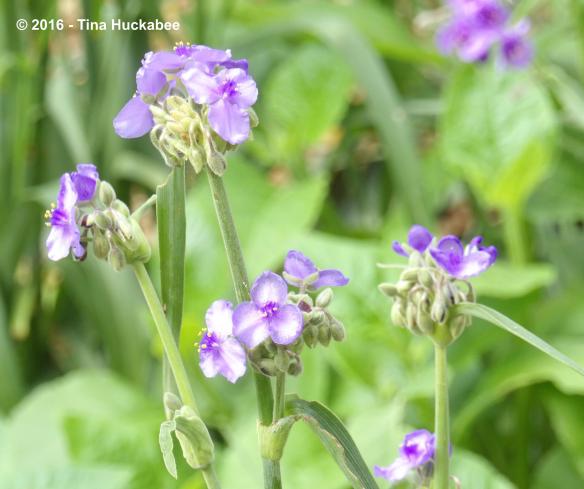





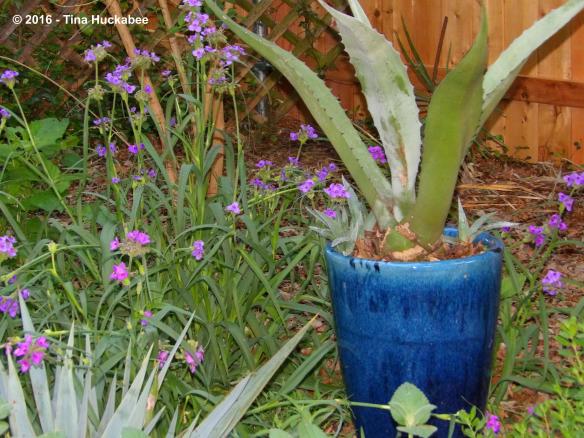


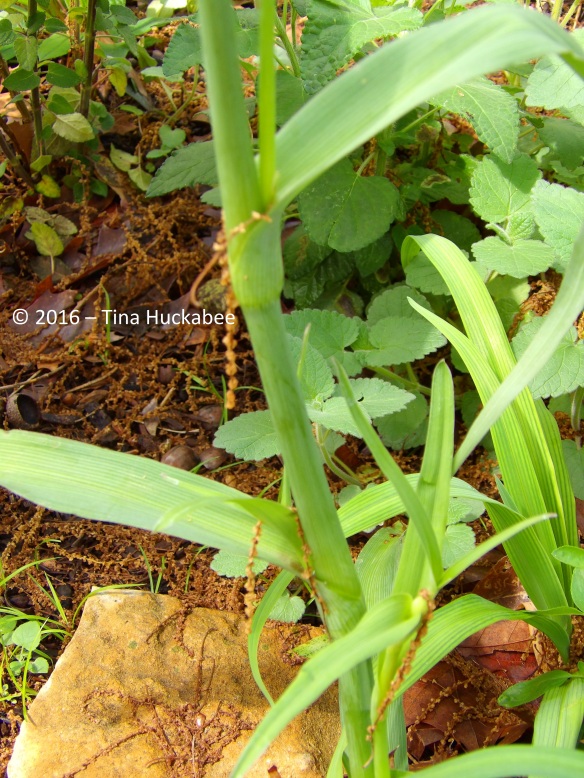

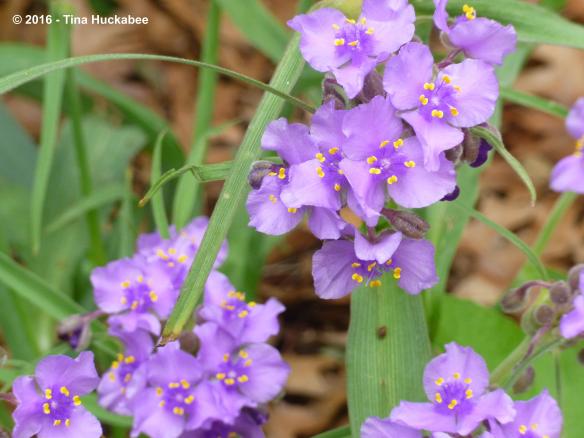

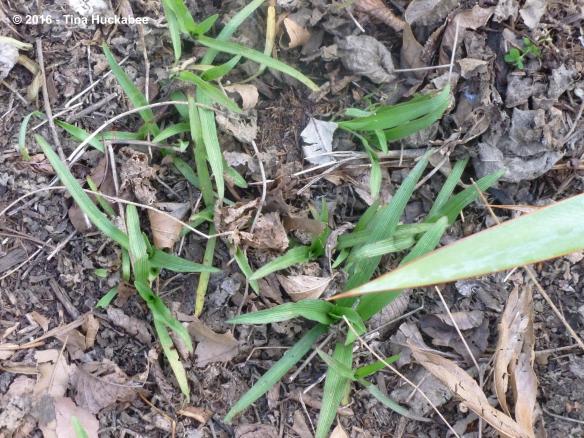



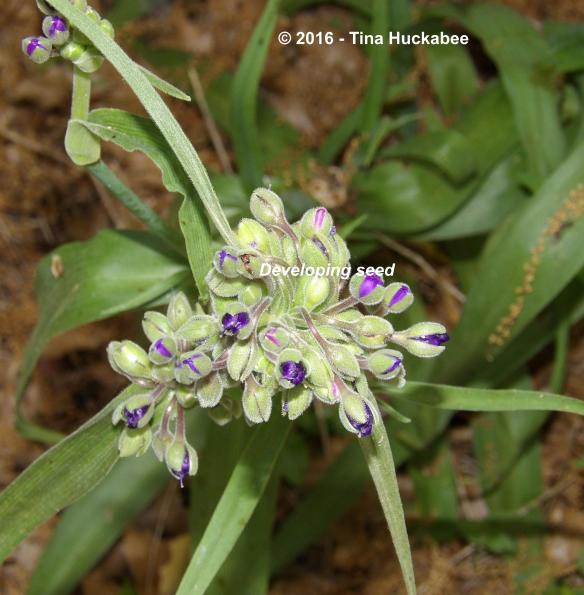


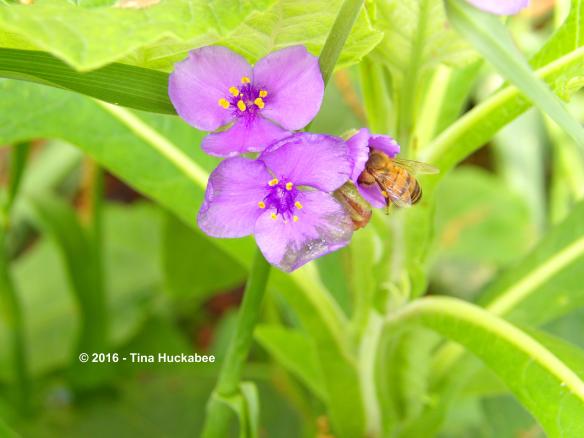







Nice that is spreads so easily as it is really pretty, but of course management necessarily becomes aggressive!
LikeLike
It’s the bane of gardening–weeding up the bounty!
LikeLike
Nice article. It is lovely. Like you I’ve learned to be ruthless in order to manage it. In the last couple of years I’ve also become allergic to the sap, so it’s best to remove it in early spring.
LikeLike
Thanks! Cruelty definitely has a place in gardening. 🙂 Interesting that you’ve developed an allergy to the sap. I guess glove wearing is not only a good idea, but mandatory for you now.
LikeLike
Very beautiful shades of purple! Tradescantia spp. are indeed a bit weedy, but as you said useful for pollinators. And what a glorious lupin!
LikeLike
Aren’t the purples pretty? One of the things I read about the Tradescantia is that the colors are dependent on soil: the more alkaline, the more purple; the more acidic, the shades tend to the blues. Our soil is alkaline–in case that isn’t obvious. 🙂 Isn’t the bluebonnet a lovely thing?
LikeLike
A Texas spring!
LikeLike
Yup!!
LikeLike
Great post – I love being able to see the plant in various stages including seed development. I like seeing some of the different varieties – you are clearly providing a happy home for these beauties! My few plants tend to bloom later than most so once I see them around town I know to keep an eye out for bloom stalks to develop here soon after.
For those of us just starting out growing these gorgeous early spring beauties, I find the clumps transplant pretty easily during their non-blooming phase with just a little extra watering to get them established. I had one clump volunteering in a path (a recurring saga here) that I carefully dug up, divided and re-established on either side of that same path in a more desirable (to the gardener at least) location. Granted the new spot was fairly shaded – moving a clump into a sunnier spot could require more care with timing for success.
Now that I’m reading about how easily they reseed, I’ll be on the lookout for baby plants to redistribute into other areas. Also – we have deer browsing frequently and they do not seem to bother spiderworts. That moves them even further up the “I want more!” list in my book. More purple is more better!
LikeLike
Thanks Deb! I’ve so enjoyed the Spiderwort in the garden, I was glad to snag some a few years back. Like yours, mine always prefer the pathways, it seems. But they are easy to move, or remove–as necessary, so I’m pleased to have them grow in the garden. Lemme know if you want some….
LikeLike
I like your tough love approach to managing this pretty little flower. I need to learn to put this in practice for some of the things growing in my garden.
LikeLike
I used to “save” every seedling, or so it seemed. But so much of what I grow seeds out and I can give the plants away (and I do), but the rogue seedlings just have to go sometimes. Having a compost bin assuages some of that guilt–at least the would-be plants are going to a good cause. Of course, I haven’t really solved the problem when the plants volunteer in the compost. 🙂
LikeLike
I just got my first spiderwort blossoms a few days ago! And have some poppies promising color soon.
LikeLike
Yay!! And poppies too! Spring has sprung.
LikeLiked by 1 person
I love the Spiderworts! It’s interesting–here in Wisconsin they seem to prefer sunnier locations. There are large swaths of them at the UW-Arboretum in mostly sun–prairie and sunny hilltop locations. Maybe it depends on the part of the country. We also have big patches of them growing naturally up at our cottage. In that setting, they’re growing in partial sun/shade. I wonder if the shade here in the north is too cold for them during the time they’re supposed to germinate and emerge. Anyway, they are fun plants with beautiful colors and loads of character!
LikeLike
I suspect your sun is a bit gentler than ours. 🙂 I’ll bet a swath of spiderwort across a hilltop is quite stunning. It would make sense that yours thrive in sunnier spots and maybe find the shade areas too chilly. Spiderwort is a fun plant–lots of variety in color, size and they do have “loads of character.” Great description, Beth.
LikeLike
I look forward to seeing your Bluebonnets…what a sight. I also love Spiderwort and have it growing all over the garden in late spring…I am seeing signs of it waking now. I love the surprise blooms all over the back gardens!
LikeLike
The bluebonnets are lovely this year, though I’ve only seen them around town and not out in the Hill Country. I think the most gardeners love spiderwort–so cheery and springy they are!
LikeLike
As Beth says for Wisconsin–in WY and SD spiderworts seem to prefer open prairies. They aren’t that common where I’ve been, so it’s a treat to find them. And I’m always reminded of a Dakota story. When a young man found a spiderwort in bloom, he would sing to it as if it were his sweetheart, composing lyrics about her beauty and charm. 🙂
LikeLike
Oh, Hollis, what a sweet tale–thanks for sharing that! It makes sense that in cooler areas, the spiderwort would prefer sunnier spots and the opposite too.
LikeLike
It really s a beautiful plant but one which has difficulty in my rocky soil. Still I keep trying. I did have one success this year at the front of the bed where the soil is a little deeper. On the ohter hand my weeds are bluebonnets.
LikeLike
That all makes sense to me, Jenny. I do have decent soil rather than the rocky soil of the more western parts of the Austin area. And bluebonnet will love that rocky soil–they thrive on it!
LikeLike
Pingback: The Spring Garden | My Gardener Says…
Gorgeous! I really like spiderwort/ Hope mine will be as successful as yours clearly are.
LikeLike
Thanks, though I didn’t really have that much to do with them being so pretty–they do that just fine on their own. If you want some more….
LikeLike
Pingback: Winter(?) Blooms | My Gardener Says…
Ha! I went looking for information on how many species of spiderwort we have in Texas, and look whose post was near the top of the list of results! I really enjoyed all the details here. So much that you had to say I’ve read elsewhere — about hybridizing, the relationship of soil to color, and so on. You confirmed something else I mentioned to a reader — these plants will spread. I’m going to send her a link to this post, since she’s muttering about starting some in her garden. I know it will help her out, especially since she’s within a hundred miles of you.
LikeLike
I love them, but they’re really seedy-outy. (That’s not a technical term. 🙂 ) Mine are passalongs, and I think they’re Giants, but the truth is that I really am not positive. Also, I’m not a botanist. If your friend comes to Austin, have her contact me–I’ve got tons of them and love to give them away!
LikeLiked by 1 person
Pingback: The Natives are Restless | My Gardener Says…
Pingback: Time Outdoors | My Gardener Says…